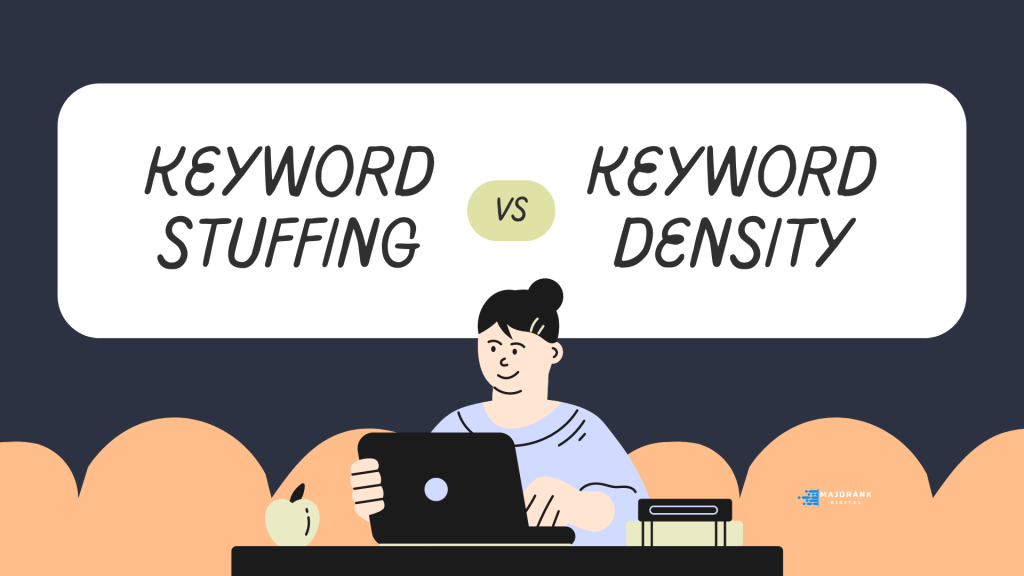
When I first ventured into the world of SEO, keywords were like mysterious keys to unlock the treasure chest of higher search engine rankings. I quickly learned that using keywords strategically was essential, but there was a fine line between effective optimization and going overboard.
In this article, I’d like to share my journey of understanding the difference between keyword stuffing and keyword density in SEO.
Keyword Stuffing
Keyword stuffing is the practice of overloading a webpage’s content with an excessive number of keywords or keyword phrases in an attempt to manipulate search engine rankings.
This tactic was more prevalent in the early days of SEO when search algorithms were less sophisticated.
The Downside of Keyword Stuffing
- User Experience: Keyword-stuffed content is often unreadable and fails to provide value to users. Visitors are quick to bounce from such pages.
- Search Engine Penalties: Major search engines like Google have become adept at detecting keyword stuffing. When caught, websites face penalties, including lower rankings or even exclusion from search results.
- Reputation Damage: Keyword stuffing can harm your brand’s reputation, making it appear spammy and untrustworthy.
Example of Keyword Stuffing:
Imagine you’re searching for a recipe for chocolate cake, and you come across a webpage that looks like this:
“Looking for the best chocolate cake recipe? Our chocolate cake recipe is the best chocolate cake recipe you’ll ever find. Our chocolate cake is made with the finest chocolate. If you want a chocolate cake recipe that’s delicious and easy, this chocolate cake recipe is the one for you.”
My Encounter with Keyword Stuffing
Early on, I stumbled upon the concept of keyword stuffing. It seemed like an easy way to climb the search engine ranks. So, I decided to give it a try on my blog.
I wrote a blog post about “best travel destinations,” and instead of carefully selecting relevant keywords, I went on a keyword spree.
My content ended up looking like this:
“Are you looking for the best travel destinations? Our website has the best travel destinations for all your travel needs. We offer the best travel destinations for budget travelers, luxury travelers, and adventure seekers. If you’re seeking the best travel destinations, you’ve come to the right place for finding the best travel destinations.”
At first, I thought I had cracked the SEO code, but the results were far from what I expected. Users were bouncing off my page like it was on fire, and my search engine rankings dropped like a lead balloon.
Also Read About – What is Keyword Stuffing in SEO
The Eye-Opener: Keyword Density
After my failed experiment with keyword stuffing, I decided to delve deeper into SEO. That’s when I stumbled upon the concept of keyword density—a more subtle and user-friendly approach to SEO.
Keyword density refers to the percentage of times a keyword or phrase appears in your content compared to the total word count. It made sense; rather than cramming keywords haphazardly, I needed to focus on creating valuable, informative content that naturally incorporated my chosen keywords.
So, I revamped my approach. I researched relevant keywords for my content, and this time, I weaved them seamlessly into my articles.
For example, in a piece about “sustainable gardening,” I wrote:
“Sustainable gardening is not just a trend; it’s a way of nurturing the environment while enjoying the fruits of your labor. When practicing sustainable gardening, consider using organic fertilizers and natural pest control methods. Sustainable gardening promotes harmony with nature.”
This approach felt more authentic and respectful to my readers, and it had positive results.
The Benefits of Keyword Density
- Better User Experience: Content optimized for keyword density remains readable and relevant to users, enhancing their overall experience.
- SEO Benefits: Maintaining an optimal keyword density can improve your search engine rankings, making your content more discoverable.
- Content Quality: Focusing on keyword density encourages writers to create high-quality, informative content around a specific topic.
Example of Proper Keyword Density:
Suppose you’re searching for a fitness blog on “cardiovascular health,” and you land on a page with the following content:
“Cardiovascular health is essential for overall well-being. Engaging in regular aerobic exercises like jogging, swimming, or cycling can significantly improve cardiovascular health. Incorporating cardio workouts into your fitness routine can lower the risk of heart disease and promote a healthy heart.”
Finding the Right Balance for Keyword Stuffing vs Keyword Density
So, how do you strike the right balance between keyword stuffing and keyword density?
- Keyword Research: Start by conducting thorough keyword research to identify relevant keywords and phrases for your content.
- Natural Integration: Seamlessly integrate keywords into your content so that they flow naturally and make sense within the context.
- Use Synonyms: Instead of repeating the same keyword, use synonyms or related terms to diversify your content.
- Quality Over Quantity: Prioritize creating valuable, informative, and engaging content that addresses the needs and questions of your target audience.
- Regular Monitoring: Keep an eye on your content’s performance and make adjustments as needed. SEO is an ongoing process.
Conclusion
In conclusion, keyword stuffing is a dated and risky SEO tactic that can lead to poor user experiences and penalties from search engines. Instead, focus on keyword density—a more nuanced approach that benefits both users and search engines.
By striking the right balance, you can improve your website’s visibility, attract more organic traffic, and ultimately achieve your SEO goals.
Remember, content should be written for humans first, and SEO should enhance, not detract from the user experience.






